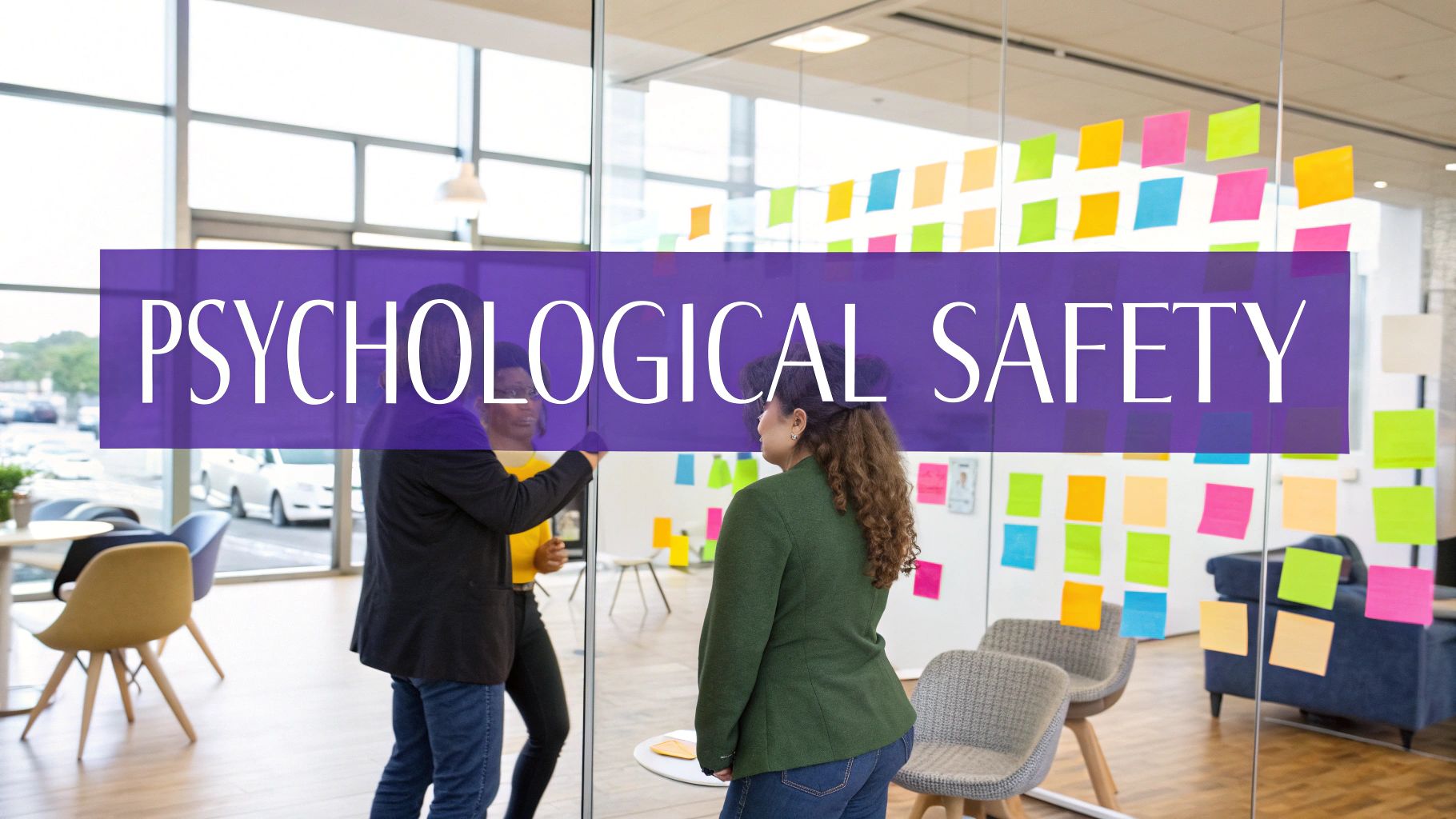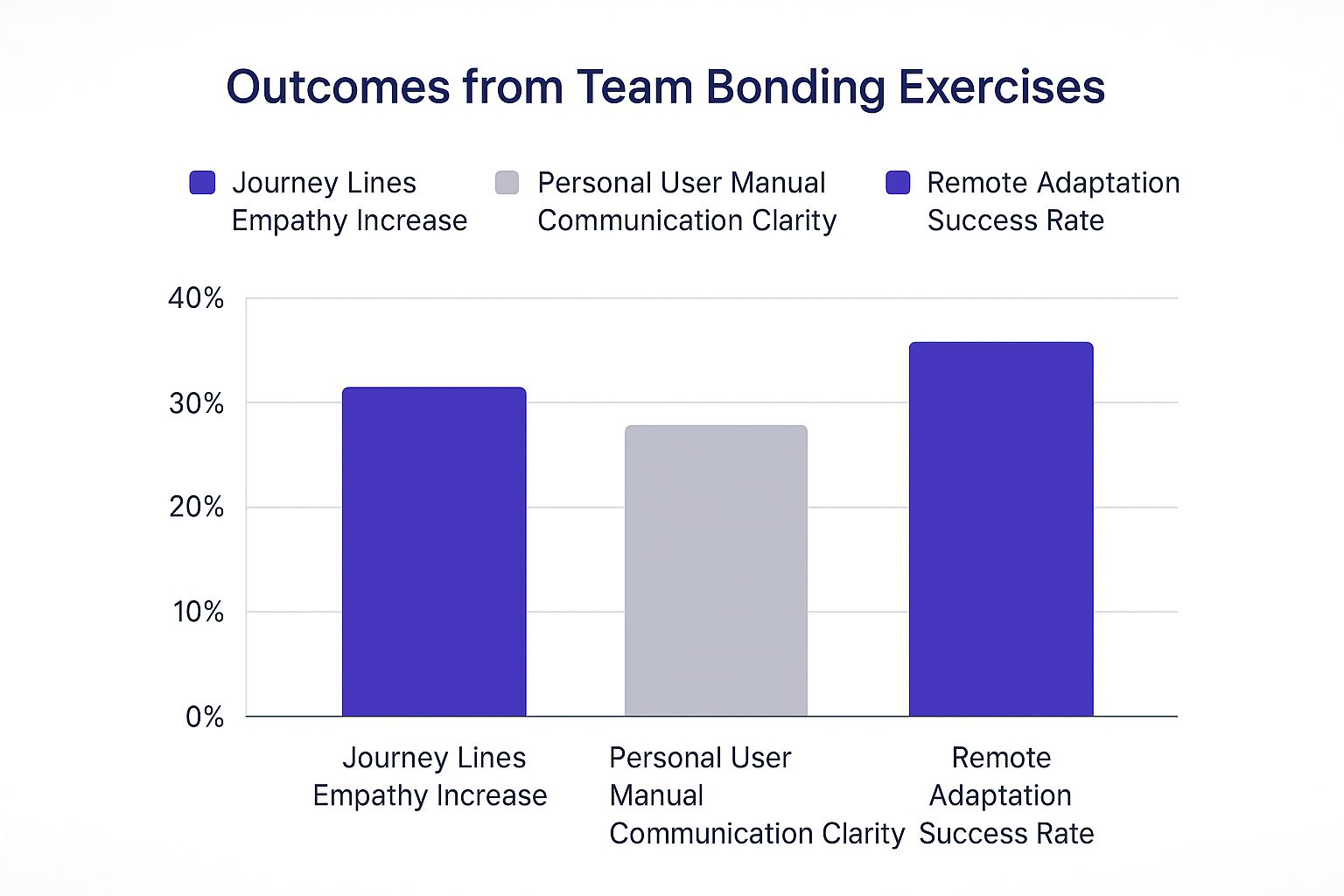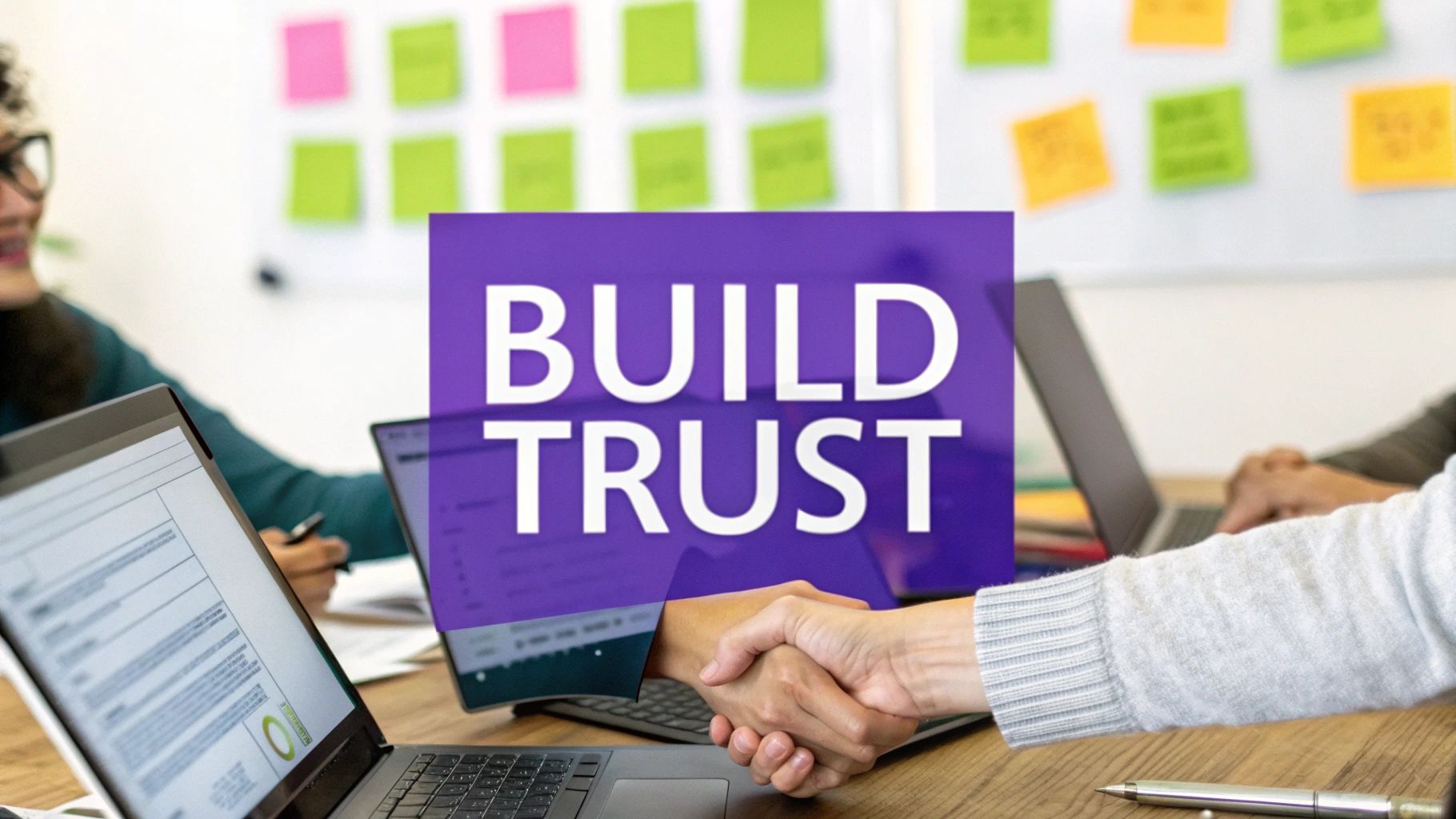Building trust in teams isn’t just a feel-good exercise; it’s the strategic bedrock of everything that makes a workplace truly succeed, from genuine collaboration to outstanding performance. It doesn't just happen on its own. It's carefully built through consistent actions, clear communication, and a real willingness to be vulnerable and reliable with each other.
Why Trust Is the Engine of Great Teams

"Teamwork" is a word we hear so often it’s easy to tune out. But real, effective teamwork is simply impossible without trust. It’s the invisible glue that turns a group of talented individuals into a cohesive, high-performing unit.
This is what separates a team that innovates under pressure from one that crumbles when things get tough.
When people genuinely trust their colleagues, they feel a sense of psychological safety. This frees them up to take smart risks, throw out a half-baked idea without fearing ridicule, and own up to mistakes. Instead of wasting time and energy on office politics or watching their backs, they can pour that energy into solving big problems and hitting shared goals. This isn't just a nice-to-have part of the culture; it directly and measurably impacts the bottom line.
The Real-World Impact of High-Trust Cultures
The business case for fostering trust is crystal clear. High-trust environments consistently lead to better outcomes across the board. Just look at the research from Gallup—it found that teams with high levels of trust are a staggering 50% more productive than their counterparts.
Why? It comes down to better communication, more open collaboration, and a genuine willingness to innovate. The same findings show that trust can reduce employee stress by 74%, which naturally leads to more energized and engaged teams. For more on this, you can explore the research on trust-building activities.
This translates into tangible benefits you can see every day:
- Faster Decision-Making: Teams move quicker because they aren't second-guessing each other's motives or competence.
- Increased Innovation: People are far more willing to propose creative, outside-the-box solutions when they know their ideas will be treated with respect.
- Higher Employee Retention: A supportive, trust-based culture is one of the main reasons talented people choose to stay with a company.
The difference between a low-trust and high-trust team isn't subtle. It shows up in daily interactions, project outcomes, and overall morale.
Here's a quick look at how these dynamics play out in the real world.
High-Trust vs Low-Trust Team Dynamics
| Characteristic | Low-Trust Teams | High-Trust Teams |
|---|---|---|
| Communication | Guarded, indirect, and often filtered. Information is hoarded. | Open, honest, and direct. Information flows freely. |
| Collaboration | Siloed work, reluctance to help others, and a focus on individual credit. | Eager to help, shared ownership of successes and failures. |
| Conflict | Avoided or becomes personal and destructive. Grudges are common. | Seen as healthy and productive. Debates are focused on ideas, not people. |
| Risk-Taking | Fear of failure paralyzes innovation. People stick to the "safe" path. | Encouraged. Mistakes are viewed as learning opportunities. |
| Accountability | Finger-pointing and blame-shifting are the norm when things go wrong. | Individuals take ownership of their responsibilities and commitments. |
| Morale & Burnout | High stress, cynicism, and frequent burnout. A sense of "every person for themselves." | High energy, genuine engagement, and a strong sense of belonging and mutual support. |
As you can see, the environment in a high-trust team is fundamentally more resilient and productive. It’s a place where people can do their best work.
A team that lacks trust is just a group of people working near each other. A team that has built trust operates as a single, powerful entity capable of achieving extraordinary results.
Trust as a Strategic Advantage
Ultimately, learning how to build trust is a strategic imperative, not just a soft skill. It's the foundation for everything else, turning raw potential into powerful performance. For more on this, you can also explore our guide on building high-performance teams.
Create a Culture of Psychological Safety

Before your team can trust each other's work or count on one another to hit deadlines, they need to feel fundamentally safe. This concept, known as psychological safety, is the absolute bedrock of a high-trust team. Without it, everything else crumbles.
Think of it as the freedom to be human at work. It's the shared belief that you won't be punished or humiliated for speaking up, asking a "stupid" question, admitting you don't know something, or even pitching a wild, half-baked idea. When people feel safe, they stop worrying about protecting their image and start channeling that energy into solving problems together. This is the secret sauce for building innovative and resilient teams.
I once worked with a manager whose team was paralyzed by a fear of failure. They’d only bring forward perfectly polished, "safe" ideas, and any project that went sideways was immediately buried. He knew this was killing their creativity, so he decided to lead by example. In the next team meeting, he walked everyone through a major project he led years ago that had failed—spectacularly. He didn't hold back, detailing what went wrong and, more importantly, what he learned from it.
That one act of vulnerability completely shifted the dynamic. It signaled that mistakes weren't just okay; they were valuable learning experiences. You can explore the core ideas of what psychological safety at work really means in our dedicated guide.
From Blame to Learning
One of the most effective ways to build this culture is to change how your team talks about mistakes. Ditch the old-school postmortems, which can easily turn into a witch hunt. Instead, start running blameless postmortems.
The goal here isn't to find a scapegoat. It's to understand what happened and why. This shifts the focus from individual blame to systemic issues and gaps in your process.
The core idea behind a blameless postmortem is to treat every failure as a system problem. This creates an environment where people feel safe enough to be honest about mistakes, which is the only way you can truly learn and prevent them from happening again.
To make this happen, you need to ask the right questions. Try framing your discussions around these points:
- What was the outcome we expected?
- What was the actual outcome?
- What did we learn from the gap between the two?
- How can we improve our process to get closer to our expected outcome next time?
By consistently focusing on learning over blame, you show your team that it's safe to be transparent. Failures transform from something to be feared into a powerful tool for growth, building the kind of deep, resilient trust that empowers a team to tackle anything.
Build Trust Through Competence and Reliability

While psychological safety gives people the freedom to be vulnerable, another kind of trust is essential for getting things done: competence-based trust. This is the rock-solid confidence you have that your teammates not only have the skills for the job but will actually follow through on their promises.
It's the simple belief that when someone says, “I’ve got this,” they mean it.
This isn't built on grand gestures or one-off heroics. It's forged in the small, consistent actions of day-to-day work. Every deadline met, every task completed well, and every proactive status update adds another brick to this foundation. Without it, you get micromanagement, duplicated effort, and that nagging anxiety about whether projects will ever get finished.
Establish Clarity and Foster Accountability
The fastest way to build this kind of trust is to kill ambiguity. When expectations are fuzzy, accountability is impossible, and trust disappears right along with it. The solution is to make commitments and progress visible to everyone on the team.
This is where shared project management tools like Asana, Trello, or Jira really shine. They aren’t just for tracking tasks; they’re trust-building machines. When the whole team can see who owns what and where each piece of the puzzle stands, a culture of natural accountability emerges.
Suddenly, you don't need to chase people for updates because the information is already there. This transparency is a huge part of knowing https://www.remotesparks.com/how-to-improve-team-communication/ and cutting out unnecessary friction.
Trust is simply the expectation that people will do what they say they will. It’s built when your actions consistently match your words.
The Power of Consistent Follow-Through
I once worked with a fully remote software team that nailed this with a simple daily check-in. At the start of each day, everyone posted their top one or two priorities in a dedicated Slack channel. At the end of the day, they’d follow up with a quick progress update.
This wasn't about surveillance; it was about creating a predictable rhythm of commitment and delivery. It was a low-effort way for everyone, scattered across different time zones, to see their teammates consistently doing what they said they would. That simple habit built more competence-based trust than any complicated process ever could.
This just goes to show how essential trust is for performance and engagement. Research shows that after seeing the benefits of trust-focused training, between 80% and 100% of employees would recommend it. What's more, 85% of people agree trust is a cornerstone of team success. You can discover more insights about team-building strategies and their impact.
Ultimately, reliability is a skill. And when a team practices it together, trust becomes the natural outcome.
Lead With Authentic Transparency
Trust in a team doesn't just happen on its own. It's not something that bubbles up from the bottom; it almost always cascades down from the top. When leaders are genuinely transparent, they set the standard for everyone else. This is about more than just being honest—it’s about consistently showing up as a real person whose words actually match their actions.
This kind of leadership creates a powerful ripple effect. When your team sees you openly admit to a mistake, share the thinking behind a tough call, or deliver bad news with candor, they feel safer. They get the context for their work and feel respected enough to be let in on the bigger picture.
The Two Types of Leaders: Hoarders vs. Sharers
Think about the two kinds of managers you’ve likely encountered. The first type hoards information, treating it like a source of power. Their team is constantly in the dark, feeling like interchangeable parts in a machine they don't understand. This breeds suspicion and kills engagement, as people inevitably fill the silence with their own—usually negative—assumptions.
Then there's the other type of leader, the one who shares information freely. They’re open about the challenges the team is facing, they celebrate wins collectively, and they make sure everyone understands the "why" behind major decisions. This approach builds a bridge of trust by showing the team they are valued partners, not just employees.
Sadly, this isn't the norm. A recent study found that only 23% of U.S. employees strongly trust their leadership. That's a huge gap, but it also points to a massive opportunity. Authenticity and a real willingness to listen are what turn this statistic around. The payoff is significant—companies that focus on these bonds see a 36% higher employee retention rate. You can read more about these team-building statistics to see the full impact.
How to Put Transparency Into Practice
So, how do you actually start leading with more transparency? It comes down to building intentional communication habits that show your team you have nothing to hide.
- Host 'Ask Me Anything' (AMA) Sessions: Set up regular, open forums where no question is off-limits. This is a fantastic way to demystify leadership decisions and tackle concerns head-on before they fester into rumors.
- Always Share the 'Why': Don't just announce a new project or a change in direction. Walk your team through the reasoning—the data you looked at, the problem you're trying to solve, and the goal you're aiming for. Context changes everything.
- Deliver Bad News Directly: When you hit a roadblock or a setback, be the first to talk about it. Nothing erodes trust faster than avoiding a difficult conversation. People respect honesty, even when the news isn't great.
True leadership transparency isn’t about oversharing every little detail. It's about giving your team the right context so they feel informed, respected, and trusted to handle the truth.
This kind of open dialogue is especially powerful in smaller, more personal settings. To create more of these opportunities, check out our guide on structuring an effective one-on-one meeting, which is the perfect place to build individual trust.
When you lead by example, you're doing more than just managing a team—you're cultivating a culture where trust can actually thrive.
Use Practical Exercises to Strengthen Bonds
Talking about trust is one thing, but actually building it is another. It takes more than just saying the right words; you have to put that intention into action. Forget the awkward trust falls or cheesy icebreakers you might be thinking of. To build real connections, especially when your team is spread out, you need structured exercises that get people to open up and genuinely understand each other.
These aren't just fluffy "team-building" activities. They're carefully designed to help people see their colleagues as more than just a name on Slack—as real people with unique stories, preferences, and motivations. That shared understanding is the secret sauce for creating the psychological safety and closeness that high-performing teams thrive on.
Facilitate a Journey Lines Session
One of the most powerful exercises I've seen for building empathy is called Journey Lines. The idea is simple but incredibly effective: each person on the team maps out the significant highs and lows of their personal and professional life on a timeline.
The goal isn't to force anyone to share their deepest secrets. It's about creating a safe space for people to share what they're comfortable with. As colleagues walk through their journeys—sharing triumphs and acknowledging challenges—they gain a much deeper appreciation for the experiences that shaped the person they work with every day. This kind of storytelling cuts through professional jargon and builds real human connections.
This works surprisingly well for remote teams. Just pull up a virtual whiteboard tool like Miro or Mural, and you're good to go. The key is for the leader to go first, modeling the right level of openness and setting a tone where everyone feels respected and heard.

As you can see, when these activities are adapted for remote work, the results are even better. It proves they’re not just a nice-to-have but a necessity for today’s distributed teams.
Create Personal User Manuals
Another fantastic and super practical tool is the Personal User Manual. Think of it as a "how-to" guide for working with each person on your team. It’s a straightforward document where everyone answers a few key questions about their work style.
This simple exercise takes all the guesswork out of collaboration. Instead of trying to figure people out over weeks or months, a user manual lays it all out from the start. To make this even more effective, you can weave in other targeted team building activities for remote workers.
A great manual answers critical questions like:
- My working style: "My deep work hours are from 8-11 AM. If you can, please try to schedule meetings outside that window."
- How to best communicate with me: "Slack is perfect for quick questions, but if you need a thoughtful response, email is always better."
- What I value in others: "I really appreciate direct, honest feedback. Don't worry about hurting my feelings!"
- How to help me: "I sometimes get stuck and don't ask for help, so a quick 'how's it going?' check-in can make a huge difference."
A Personal User Manual is an act of generosity. It tells your colleagues, "I want us to work well together, and here's the information you need to make that happen." It’s a proactive step toward clearer communication and fewer misunderstandings.
By sharing these manuals, your team develops a common language for how to interact. It's a simple document, but it's a powerful resource that builds trust by making everyone's needs and preferences clear from day one.
To help you choose the right exercise, here's a quick guide.
Trust-Building Activities for Modern Teams
This table is a quick reference to help you select the right trust-building exercise based on your team's specific needs and whether you're working in-person, remotely, or in a hybrid model.
| Activity Name | Objective | Best For (Remote/Hybrid/In-Person) | Time Required |
|---|---|---|---|
| Journey Lines | Build deep empathy and personal connection | All | 60-90 minutes |
| Personal User Manuals | Clarify work styles and communication preferences | All | 30-45 minutes |
| Two Truths and a Lie | A lighthearted icebreaker to share fun facts | All | 15-20 minutes |
| Virtual Coffee Chats | Foster informal, non-work-related conversations | Remote, Hybrid | 15 minutes |
| Strengths Spotting | Recognize and appreciate colleagues' talents | All | 20-30 minutes |
Picking the right activity can make all the difference. For even more ideas and detailed instructions, check out our complete guide on group activities to build teamwork.
Common Questions About Building Team Trust
Even when you're doing everything right, building a high-trust team can be a winding road. It's only natural to have questions along the way. Knowing what to expect—the hurdles, the timelines, the pitfalls—helps you stay the course. Let's tackle some of the most common questions I hear from leaders.
How Long Does It Really Take to Build Trust?
This is usually the first thing people ask, and the honest answer is: it depends. Trust isn’t something you achieve overnight. While you can often feel a real shift in team dynamics within three to six months of focused effort, deep, resilient trust is something you build every single day.
It's a marathon, not a sprint. A fun offsite can give you a nice little boost, but lasting trust is forged in the small, consistent moments—meeting deadlines, showing up for a teammate, having an honest conversation. It’s the sum of those reliable actions that really counts.
Trust isn’t a one-time initiative; it’s a daily practice. Consistent, trustworthy behavior is what builds the foundation, not a single workshop.
Can Our Team Rebuild Trust After It's Been Broken?
Absolutely. But it's going to be tough. Rebuilding trust is a lot harder than building it from scratch because you're fighting against a history of letdowns. It takes a massive amount of patience, humility, and a very deliberate game plan.
It has to start with a genuine, public acknowledgment of what went wrong. The leader or person responsible needs to own it completely, with no excuses. Then, they have to share a clear, concrete plan to ensure it never happens again. After that, it’s all about consistent, visible proof that things have changed. Words mean nothing without actions to back them up over the long haul.
For a deeper dive into this topic, you can explore some additional insights into building team trust.
What Are the Fastest Ways Leaders Destroy Trust?
Building trust takes time, but destroying it can happen in an instant. A few specific leadership behaviors are like poison to the psychological safety that trust relies on.
Knowing what these trust-killers are is half the battle. Steer clear of these at all costs:
- Micromanaging: This screams, "I don't trust you." It kills autonomy and tells your team you have zero faith in their skills.
- A Lack of Transparency: Holding back information or sugarcoating bad news makes people feel out of the loop. It breeds paranoia and rumors, which are toxic to a trusting environment.
- Playing Favorites: Nothing erodes fairness faster. When your team sees that the rules don't apply to everyone equally, they lose faith in you and the entire system.
- Failing to Give Credit: When someone’s hard work goes unnoticed—or worse, is claimed by a manager—it's a huge blow. Recognizing contributions is a fundamental sign of respect, and you can't have trust without it.
Each one of these actions strikes right at the heart of what it takes to build a thriving, high-trust team.
Ready to transform your team's creative process? Bulby provides the structured brainstorming tools you need to build trust and generate brilliant ideas. Discover how Bulby can guide your team to innovation today!

